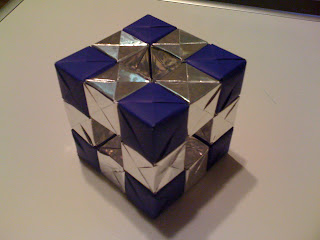Well, it certainly seems to have been a long time since I posted or updated anything here! Shame on me! I've started at a whole new school, entered into a new field, and am in the process of gaining certifications... so I've been a bit busy. Still, I can't seem to stop folding.
This is Barth Dunkan's "Parrot". With a tutorial by Jo Nakashima over on YouTube. Not too terribly difficult to fold and Jo Nakashima's tutorial is very clear and precise in its direction.
OhGee's Creations
Friday, April 25, 2014
Tuesday, November 2, 2010
Shelf
This is my current origami display shelf. The models I've 'blogged' about so far are up there and some that I've not written anything about as well. I think my favorite out of the set are the three framed snowflakes. ^_^
Friday, October 29, 2010
Buckyball
Started on a 270 unit buckyball made out of Tom Hull's PHiZZ units a few days ago. Slow going, but i made steady progress.
I had a bunch of blue piece of kami paper left over from a crane project I was doing for school. Decided to use it for a good time-sink project.
The start of a long journey...
I had a bunch of blue piece of kami paper left over from a crane project I was doing for school. Decided to use it for a good time-sink project.
Started with a pentagon, then did a few hexagons.
P
HH
HHH
PHHP
That was my basic pattern where the 'P' is a pentagon (white PHiZZ units) and the 'H' is a hexagon (blue PHiZZ units). Using that pattern there were two hexagons between each and every pentagon. I then just began to repeat that pattern over and over again.
There is the first completed section using the P and H layout above. You can count the hexagons and pentagons. Pretty neat, hmmm?
Top section is completed. From here I am going to flip it over and build up from there. It's a nice dome now, but not much of a sphere.
It's definitely beginning to take a ball shape now. Mostly complete, just about a quarter of the units left that need to be folded and added on to it.
Yay, the completed ball. Took about two days to fold and assemble. It's a new show piece for my collection. ^_^
Wednesday, October 27, 2010
Snowflake (Dennis Walker)
No modular unit with this update. I am folding some snowflakes for decorations at work. I love how simple this model really is. It looks so very complicated, but is nothing but simple folds. Anyone that can fold a traditional crane can handle this model.
Ignore me in the background.
I framed this one for two reasons. One, it was easier to take a picture of. Two, I needed a good way to force it flat for a while and I had no books nearby. I recommend using tracing paper or some other translucent type of paper. Doing that will give a nice layered effect when under a light or against a dark background.
Wednesday, October 20, 2010
Icosahedron (Nick Robinson's trimodule)
Folded over the span of two days. Pretty simple units to fold, but difficult to put together because they do not lock very well. Folding instructions for the unit can be found on Nick Robinson's website. It's a nice unit that can be used to fold both 2D and 3D models. I will fold a few flat models later, but here is a 3D one for now.
Very simple unit. Needed 30 of these.
The units fit together in groups of three. I am usually an origami purist, but tape/glue would have made this a lot easier.
One ah-ah-ah, Two ah-ah-ah, Three ah-ah-ah...
The final model looks good and seems pretty solid now that all the pieces are in place. With an acute angle formed between each spike, it locks the units together pretty well.
20 Spikes total. ^_^
Monday, October 18, 2010
Level One Menger Sponge
"In mathematics, the Menger sponge is a fractal curve. It is a universal curve, in that it has topological dimension one, and any other curve (more precisely: any compact metric space of topological dimension 1) is homeomorphic to some subset of it. It is sometimes called the Menger-Sierpinski sponge or the Sierpinski sponge. It is a three-dimensional extension of the Cantor set and Sierpinski carpet. It was first described by Karl Menger (1926) while exploring the concept of topological dimension."
I first encountered the Sonobe unit in the book "Modular Origami Polyhedra". It's a good book with a lot of neat models in it. Assembling the cube is easy, but time consuming. Alternate the colors and I recommend making one full side first and building up from there.
Keep adding the modules. Just keep building, just keep building and eventually you will be rewarded with the completed model. One level one Menger sponge.
There you go, the final model. Took about a day to complete working on it slowly. ^_^
This specific model is made out of 120 Sonobe units.
I chose two complimenting colors and folded 72 of one color (silver) and 48 of the other (blue). The different colors are almost identical. The only difference is the side of the module that is folded. Example below:
Note: Foil is highly overrated for origami.
A bunch of modules waiting to be assembled.
I first encountered the Sonobe unit in the book "Modular Origami Polyhedra". It's a good book with a lot of neat models in it. Assembling the cube is easy, but time consuming. Alternate the colors and I recommend making one full side first and building up from there.
Keep adding the modules. Just keep building, just keep building and eventually you will be rewarded with the completed model. One level one Menger sponge.
There you go, the final model. Took about a day to complete working on it slowly. ^_^
Subscribe to:
Comments (Atom)
















